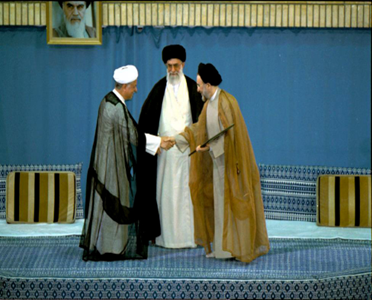After the pacification of the student demonstrations, the reformist political establishment urged a renewed focus on political elections rather than street-level activism. Although the seeds of alienation had been planted among their base, the reformists, running under the banner of the 2nd Khordad movement – a reference to the date of Khatami’s improbable 1997 victory – gained outright control of the majles in the February 2000 elections. Marring their victory, however, was the arrest and heavily politicized trial in the Special Court for Clerics of Khatami’s Interior Minister, Abdullah Nuri, a popular politician running for majles and was a probable contender for the Speaker position. In his stead, Mehdi Karroubi was re-appointed Speaker when the parliament was seated in May 2000.
The hardliners responded to the defeat by continuing to stymie the reformists, closing more reformist press outlets, and arresting more journalists. The reformist majles passed a raft of progressive legislation, including bills to improve women’s rights, but the Guardian Council repeatedly exercised its veto power over these laws. Rafsanjani had tilted more toward his natural conservative ideology since leaving the presidency, as he was wary of the reformists gaining too much power and implementing reforms that went too far in his eyes. In his role as head of the Expediency Council, he resoundingly sided with the Guardian Council against the majles, ensuring that reformist policymaking could not overcome institutional gridlock.
Reformists in the majles also introduced a proposal in August 2000 calling for reversing many of the judiciary’s closures of reformist press outlets and freeing jailed journalists. Speaker Mehdi Karroubi was forced to withdraw the bill from consideration, however, after Khamenei issued a direct decree cautioning against “the enemies of Islam, the revolution and the Islamic system taking the press in their hands.” Khamenei’s intervention was one of the first instances of him usurping the lawmaking powers of the majles, in effect legislating from on high. While more moderate in outlook, Karroubi was himself a cleric in favor of retaining and strengthening the Iranian system of clerical oversight. So he acquiesced readily to Khamenei’s expansion of power. While this forestalled an immediate crisis, it would pave the way for Khamenei to continually gain power at the expense of republican institutions.
With the liberalizing press bill shelved, the judiciary, which was accountable only to Khamenei and had its own police and intelligence services, conducted additional newspaper closures and carried out a spate of arrests targeting reformist journalists, intellectuals, students, and political and human rights leaders. Violent vigilante attacks against these constituencies escalated as well. Spooked by the student protest ordeal, Khatami urged the reformists to refrain from responding too provocatively and avoiding further demonstrations. Despite his restraint, he was unsuccessful in extracting concessions, causing his supporters, especially the youth, to grow increasingly disillusioned with reformism and politics in general.
According to Iranian-American scholar Said Arjomand, it became clear that Khamenei had outmaneuvered Khatami and ensured the death spiral of reformism despite its electoral successes. Arjomand writes that Khatami’s destruction “came in the spring and summer of 2000, at the very time of the astonishing defeat of the pro-clerical candidates in the national elections of the Sixth Majles, with the Leader’s several deadly strikes: the almost successful assassination of the president’s most important reformist aide, the clampdown on the pro-president reformist press, and, above all, his “governmental order” to the newly elected reformist Majles to stop its debate on the press law in August 2000. Khamenei embraced the president after each strike, and with each embrace came his affirmation that Khatami is one of us. Khatami did not have the courage to push him away and say he was not one of them. From then on, Khamenei knew he could do anything he wanted with the smiling Sayyed.”

Despite failing to deliver substantive, enduring reforms, Khatami had at least created an enthusiasm and optimism for change that permeated society. He was personally frustrated by the systemic obstacles preventing him from enacting change but reluctantly decided to pursue a second term. The hardliners were skilled at using the levers to block Khatami from advancing his policies, but they had not yet mastered political organizing. In the June 2001 presidential election, Khatami was the sole moderate candidate in a field of 10 allowed to run by the Guardian Council. The conservatives were generally unpopular and additionally failed to coalesce behind any single candidate. As a result, Khatami increased his share of the vote from 69 percent to 77 percent. Turnout dipped from its highwater mark of nearly 80 percent in 1997 to 66 percent, indicating the early onset of voter alienation, but the country was still overwhelmingly behind Khatami and against the conservatives. However, due to Khamenei’s obstructionism, disillusionment would quickly grow, marking the death knell of the reformist era.